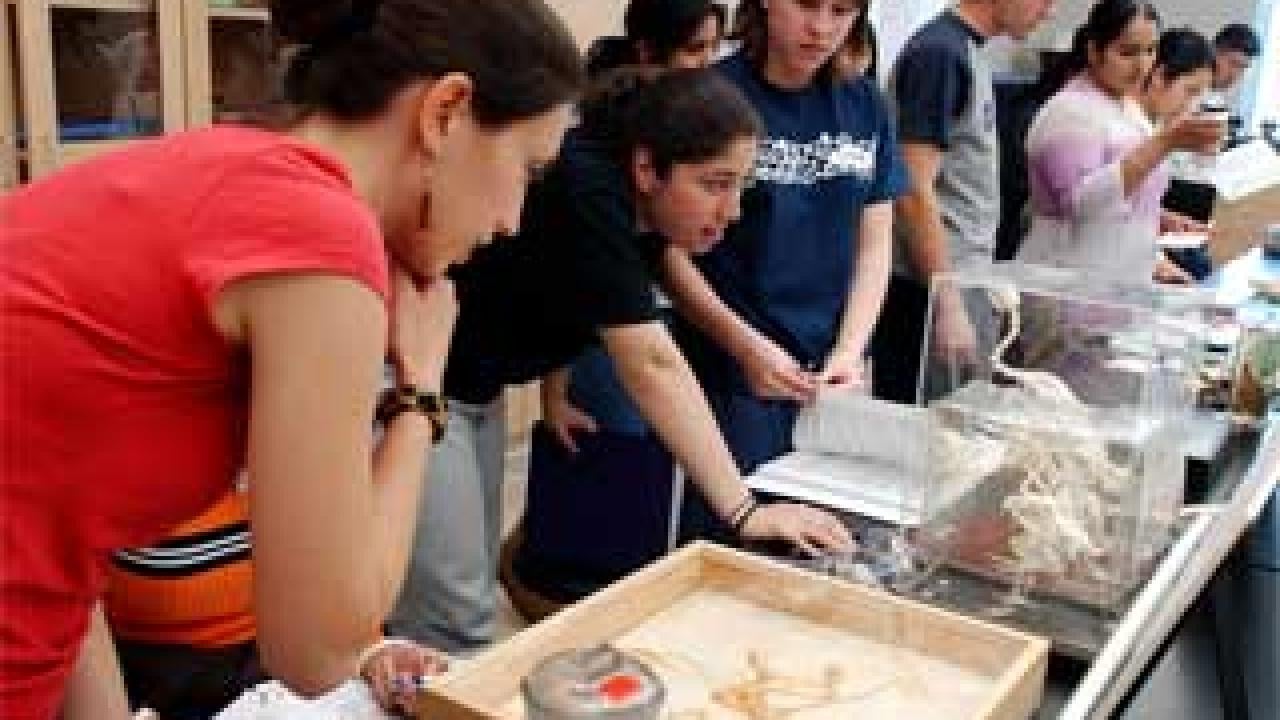The University of California, Davis, marked its commitment to the best in undergraduate science teaching today with the dedication of the Sciences Laboratory Building, designed specifically for teaching laboratory skills in biology and chemistry.
"This extraordinary building is dedicated entirely to our teaching effort and will help us provide the best of learning environments for our students in the sciences," said Chancellor Larry Vanderhoef, a plant biologist by training. "The modern classrooms and teaching laboratories will help us convey the natural excitement of science."
Phyllis Wise, dean of the Division of Biological Sciences, said that the Sciences Laboratory Building is an important addition to the life sciences neighborhood at UC Davis: "It signifies our leadership among academic institutions in the training of next-generation biological scientists and for developing a scientifically-literate student population."
The 140,000-square-foot, $52 million building was funded primarily through voter-approved funds, representing the investment of the people of California in the future education of the high-tech scientific workforce. A number of private donations financed facilities not covered by state funds, such as the Center for Plant Diversity, computer labs for bioinformatics and office space for outreach programs.
The new building is divided into "neighborhoods" reflecting the sections (departments) within the Division of Biological Sciences: Evolution and Ecology; Plant Biology; Microbiology; Molecular and Cell Biology; Neurobiology, Physiology and Behavior; and Exercise Biology; and the Department of Chemistry, part of the Division of Mathematical and Physical Sciences. Laboratory facilities are comparable to those that students will find when they leave UC Davis to begin their careers in industry and academia.
Those 34 classrooms can be busy from early morning until late at night. Some of the classes taught in the building, such as introductory chemistry and introductory biological sciences, are required for many of the degree programs at UC Davis, serving large numbers of students. For example, just one of the three introductory classes in biological sciences enrolls around 2,000 students a year. More than 5,000 students are pursuing degrees among the 13 majors offered by the Division of Biological Sciences.
In designing the building, planners took into account that effective learning requires more than classrooms. So the building includes study areas -- open at all hours -- and the "BioBrew Café." These non-classroom facilities were funded with private donations or other non-state funds. Located nearby is the new 517-seat Sciences Lecture Theater, with an ultra-high resolution projection system.
"The Sciences Laboratory Building surpasses the quality standards found in most other laboratory instructional facilities," said Professor Thomas Rost, who chaired the campuswide building committee. "By combining state-of-the-art technologies with comprehensive life science subject matter, we've raised the bar on basic science education at the collegiate level."
The building also includes some specialized facilities, such as a computer-controlled greenhouse in which students can conduct experiments with live plants. The greenhouse automatically adjusts temperature, ventilation and shading to conserve energy and maintain optimal conditions for growing plants. Sea water flumes fed by tanks in the basement house marine animals for zoology classes. With computing an ever more important part of all branches of science, computer labs are available for teaching and individual study.
The building also houses the John M. Tucker Herbarium in the Center for Plant Diversity, with its nationally recognized collection of more than 250,000 dried plants and flowers from California and around the world. The herbarium is a valuable resource for research and teaching in botany and plant biology. It also provides a plant identification service valuable to farmers and gardeners, environmentalists and weed control experts, poison control centers and even law enforcement. The new center replaces the herbarium's old, overcrowded space in Robbins Hall.
Facts about the Sciences Laboratory Building
- 141,219 gross square feet and 80,495 assignable square feet
- 34 state-of-the-art classroom laboratories, clustered by discipline
- Five student discussion rooms, learning centers and study lounges
- Two computer laboratories
- Computer-controlled teaching greenhouse
Sciences Lecture Hall
- 11,355 gross square feet
- Seating for 517
- Three projection panels and an ultrahigh-resolution projection system
Cost and funding: $52.1 million, primarily through voter-approved general obligation bonds (Proposition 1A (2000))
Architect: Zimmer Gunsul Frasca of Portland, Ore.
General contractor: Howard S. Wright Construction Company
Media Resources
Andy Fell, Research news (emphasis: biological and physical sciences, and engineering), 530-752-4533, ahfell@ucdavis.edu
Jan Kingsbury, Division of Biological Sciences, (530) 752-5824, jkingsbury@ucdavis.edu
